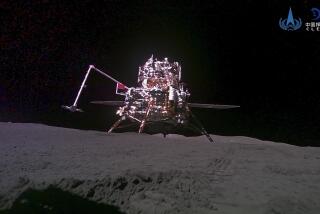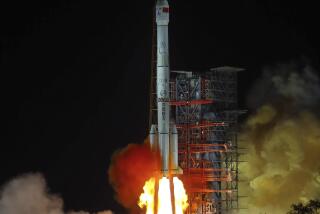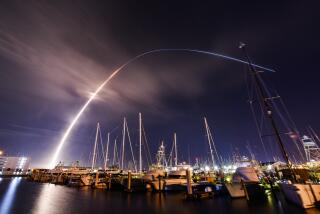China just landed on the far side of the moon. Could it become the first nation to have its own moon base?
- Share via
Reporting from Beijing — In a milestone that underscores China’s ambition to become a global leader in space exploration, the Chang’e-4 lunar lander became the first space vehicle to touch down on the far side of the moon, where it began to explore terrain that had never before been reached.
Chinese scientists have long held ambitions to establish a manned moon base and to send nuclear-powered rockets into space in future decades to colonize and exploit space. Thursday’s landing was a modest yet deeply symbolic step forward in that quest.
Chang’e-4, carrying a 300-pound lunar rover with probes and spectrometers, touched down in the Von Karman crater in the South Pole-Aitken basin, according to the China National Space Administration, which published a color photograph of the moon’s smooth surface, a crater and the dark horizon beyond.
The moon probe landed on the planned landing site, “lifting the mysterious veil” of the far side of the moon and opening “a new chapter in human lunar exploration,” the administration said.
The state-owned Global Times said it marked a major step toward the establishment of a Chinese manned lunar base — and toward deep space exploration.
Chang’e-4 was launched from the Xichang satellite launch station in Sichuan province in southern China on Dec. 8. A forerunner, Chang’e-3, landed on the moon in 2013, making China the third country after the U.S. and the Soviet Union to soft-land a spacecraft — meaning the craft would not be destroyed in the landing — on lunar soil.
This year, China is expected to launch another lunar lander that will bring samples back to Earth.
Chang’e-4’s six-wheeled lunar rover will probe the moon’s surface and transmit photographs to Earth. The mission also encompasses a biological experiment, to assess whether seeds can germinate and silkworm larvae can hatch and grow in a sealed container containing nutrients, water and air.
Chang’e-4 also carries German and Swedish research equipment to study radiation and lunar wind. It is also expected to experiment with conducting low-frequency radio astronomy observations free of interference from Earth, since the moon’s far side never faces our planet.
“The far side of the moon is a rare quiet place that is free from interference of radio signals from Earth. This probe can fill the gap of low-frequency observation in radio astronomy and will provide important information for studying the origin of stars and nebula evolution,” mission spokesman Yu Guobin told New China News Agency.

Secrecy around China’s space program is intense, and news from Chinese authorities about Chang’e-4 was limited in the lead-up to the landing, perhaps because of setbacks and failures in past missions.
Global media attention on China’s space program has often focused on those setbacks rather than the steady progress being made. In October, China’s first private rocket failed to reach orbit, and earlier in the year one of its two orbiting space stations, Tiangong-1, fell back to Earth. The previous year, two Long March rocket launches failed. However, China completed dozens of successful rocket launches last year.
Independent space expert Namrata Goswami, writing in the Diplomat, said Chang’e-4 marks China’s seriousness about meeting deadlines and targets for space travel, noting that Chinese space scientists set a 2018 deadline for a far-side lunar landing years ago.
“Significantly, China’s ambitions for the moon and outer space have only been growing, to include ambitions of a Chinese research base on the moon, as well as developing bio-regenerative life support systems to ensure that humans can settle and survive in lunar conditions,” Goswami wrote.
She said China’s ambition was to be able to “set the rules of the game in outer space” by establishing a long-term human presence.
In May, eight Chinese volunteer students concluded a yearlong test of a bio-regenerative life support system at Beihang University, an astronautics and aeronautics university in Beijing. That marked a record for human habitation in an enclosed system with recycled water, food and air — a crucial test for lunar habitation. The students grew food including wheat, potatoes, carrots, beans and onions, and ate high-protein mealworms.
Underscoring the growing strategic rivalry between the U.S. and China, President Trump has announced plans for a new military branch called a “space force.” Meanwhile, NASA announced plans in 2017 to return to the moon and establish a long-term manned lunar base “for a sustained period of exploration and use,” and as a possible launchpad for a future manned mission to Mars. NASA’s eighth spacecraft landing on Mars was in November.
But last month two NASA Apollo mission veterans warned of the need for funding, technology and a cohesive, consistent plan, complaining that successive administrations had failed to fund NASA adequately.
China’s rapid expansion of its space program has the Pentagon concerned, although China has insisted it has no plans to militarize space. In August, a Pentagon report on China’s military capabilities warned of the nation’s advances in space exploration and its capacity to use space technology for military and surveillance purposes, including the potential to knock out opponents’ satellites. China has already tested anti-satellite missiles. The Pentagon predicted China would have a manned orbiting space station by 2025. China is also swiftly developing its own global satellite navigation system, Beidou.
The lunar lander is just part of an ambitious, carefully choreographed, long-term space exploration plan that includes colonizing and exploring the commercial possibilities of the solar system and beyond.
After unmanned rocket launches, China became the third nation to independently send a human into space in 2003. It has plans to take its second space station out of service and launch a third, which will be manned. Its manned and robotic missions aim to build its technological prowess and research, and develop the capacity to send astronauts into space for longer periods. From there China plans better space vehicles, deep space exploration and exploitation of resources.
Chinese officials rarely discuss the nation’s expansive space ambitions, but in late 2017 the state-owned People’s Daily spelled out the plans of the China Academy of Launch Vehicle Technology, China’s rocket manufacturer, including plans to establish a fleet of nuclear-powered space shuttles by the 2040s for regular space flights to other planets.
In the nearer term, it aims to catch up to U.S. rocket technology, launch a Mars probe, and have a reusable shuttle by 2025 to begin space tourism.
China’s space exploration is a key part of its Made in China 2025 program, which involves attaining global leadership in space travel by the middle of the century. Chinese officials and state media have stopped using the term lately, after it was censored by authorities last year over concerns it was antagonizing the Trump administration as trade tensions between the nations mounted.
Although hopes are growing that the two nations may reach a deal to end the trade war, analysts don’t expect China to give up its aspiration to become a global leader in strategic technology such as rockets, robots and artificial intelligence.
Twitter: @RobynDixon_LAT
More to Read
Sign up for Essential California
The most important California stories and recommendations in your inbox every morning.
You may occasionally receive promotional content from the Los Angeles Times.










